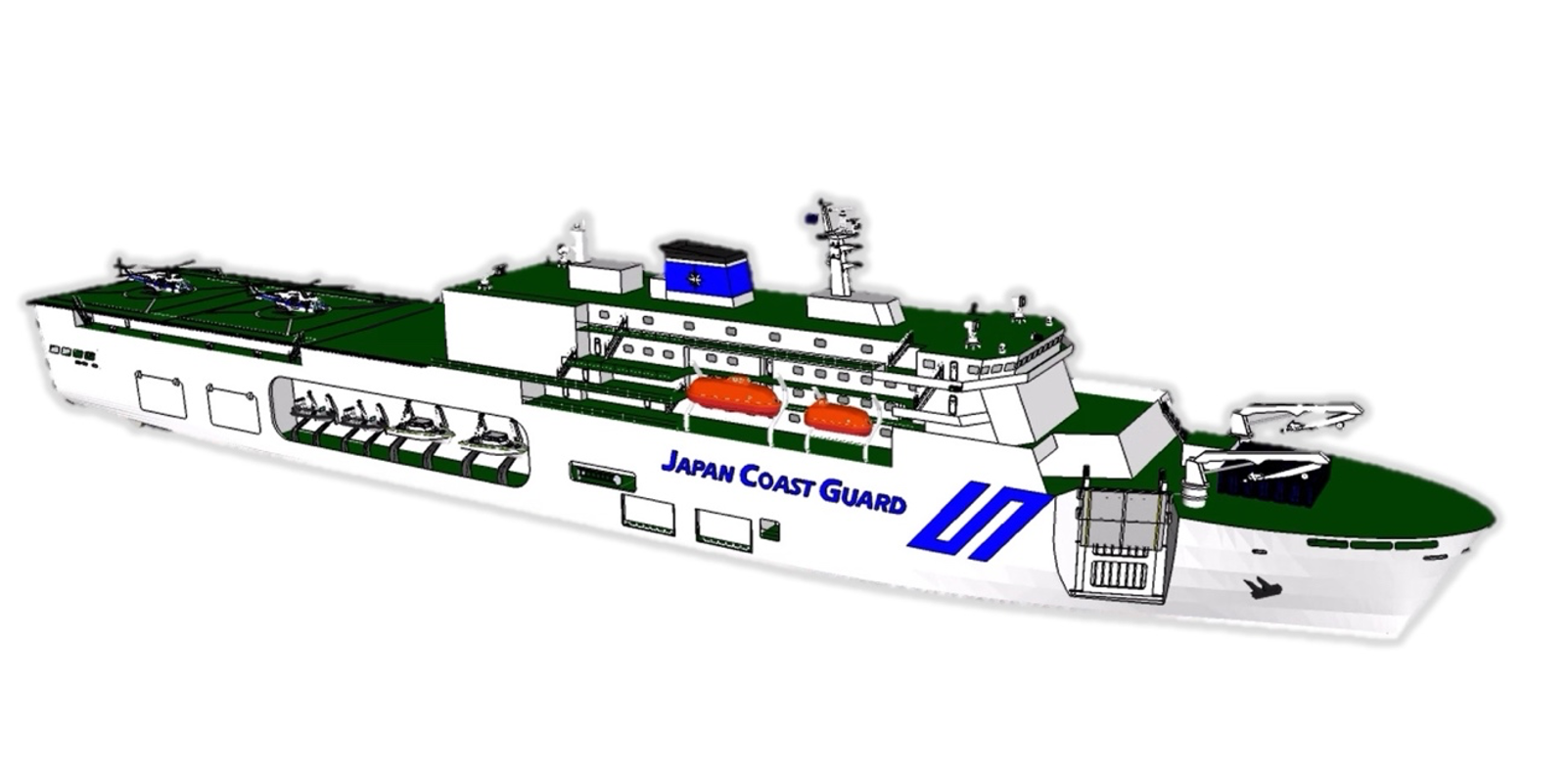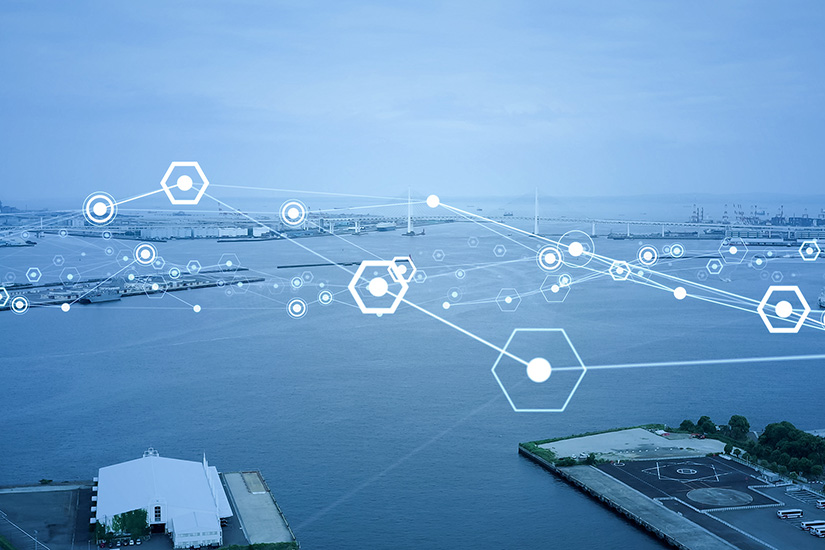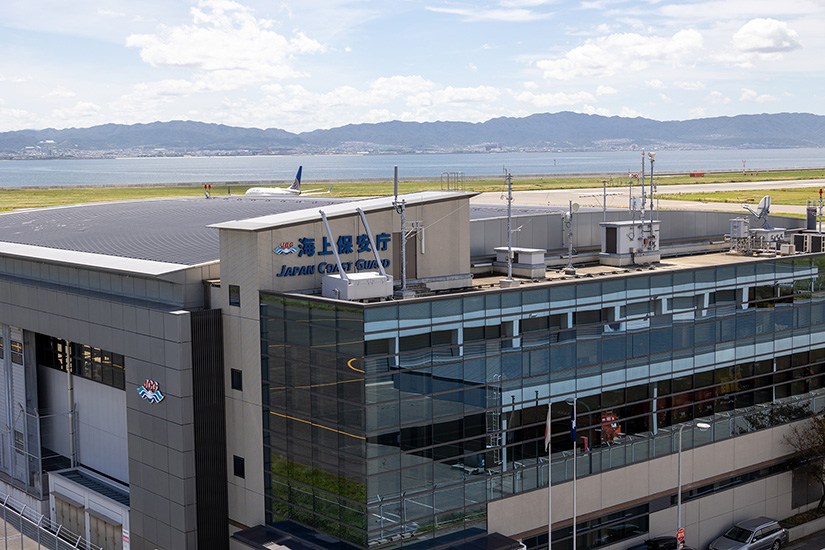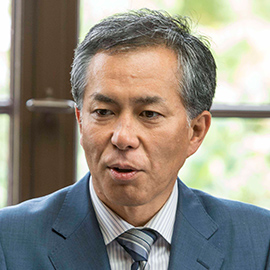Introduction
On August 27, 2024, the Japan Coast Guard (JCG) announced its fiscal 2025 budget request, totaling ¥293.5 billion. The amount was the largest ever requested and 12% higher than the previous fiscal year. The most notable feature of the budget was a plan to construct a large multipurpose patrol vessel, approximately 200 meters in length, with a gross tonnage of around 30,000 tons.[1] The ship’s size exceeds that of the Izumo-class destroyer, currently the largest vessel in the Maritime Self-Defense Force fleet (length of 248 meters and gross tonnage of approximately 20,000 tons) that is being retrofitted to accommodate state-of-the-art F-35B fighter jets.
A more concrete image of the new vessel was revealed at a ministerial meeting on strengthening Coast Guard capabilities, held at the Prime Minister’s Office on December 20.[2] The JCG has stated that a patrol vessel with high transport and command and control capabilities is needed to respond to large-scale disasters (to transport supplies and provide assistance to affected people), carry out national protection activities during emergencies (to evacuate residents), and conduct security operations and patrol territorial waters.
A 30,000-ton-class patrol vessel would be unprecedented in the JCG’s history. The largest existing patrol vessel, Akitsushima, is 150 meters long and approximately 6,500 tons. It would also be significantly larger than the biggest Chinese Coast Guard (CCG) vessels of the Zhaotou class (165 meters long and approximately 10,000 tons) and the US Coast Guard’s largest Legend-class patrol vessels (127 meters long and 4,500 tons).
Its size could be perceived as a threat, leading to heightened regional tensions. China’s Zhaotou-class 2901 and 5901, for instance, are equipped with 76-mm rapid-fire naval guns and have been dubbed the “monster ships” of the South China Sea that intimidate the fishermen of neighboring countries.[3] The passage of the 2901 near the Senkaku Islands in November 2024 prompted heavy media coverage.[4]
The new JCG multipurpose patrol vessel is much bigger than these “monsters.” Given the complex security environment in East Asia, China could claim that the ship is designed specifically to patrol the Senkaku Islands and perceive its presence as a threat.[4] If China were to respond by deploying its own large patrol vessels near the Senkakus, maritime tensions could escalate.
But does a multipurpose patrol vessel really pose a threat? In the following, I review the ship’s objectives and design, outlining why it should not escalate tensions nor result in a race to build ever bigger patrol ships.
The publicly released image of the JCG’s new multipurpose patrol vessel.

Why Now?
The JCG is tasked with complex and diverse operations in a highly challenging maritime security environment. Its activities include conducting territorial patrols around the Senkaku Islands, preventing illegal fishing by foreign vessels in the Sea of Japan, responding to North Korean missile launches, addressing unauthorized foreign maritime surveys, and responding to natural disasters.
Given this security landscape, the government established a policy for the strengthening of Coast Guard capabilities in December 2022,[6] outlining six areas requiring reinforcement, such as patrols around the Senkakus and resilience against large-scale, significant incidents occurring simultaneously. The budget request for the new multipurpose patrol vessel is part of an effort to reinforce these capabilities.[7]
According to this policy, “large-scale, significant incidents” refer to acts of terrorism, threats from North Korea, illegal fishing by foreign fishing vessels, and major disasters.[8] The JCG has played a crucial role in disaster relief, as seen during the Noto Peninsula earthquakes in January 2024, when JCG patrol vessels and aircraft while prioritizing search-and-rescue operations, assessed damage, transported relief supplies, and provided water at ports near the epicenter, like Nanao and Wajima.[9] Maritime and aerial transport have proven essential during disasters, alongside ground transport,[10] pointing to the need for patrol vessels with high transport capacity.
Hence, the new multipurpose patrol vessel is designed with significantly enhanced transport capabilities. Its spacious interior can accommodate approximately 1,000 evacuees, along with many vehicles, and its ferry-like ramp allows large buses and trucks to be easily roll on and off the ship. The vessel is also capable of supplying water to disaster-stricken areas and can operate multiple small boats and helicopters simultaneously, which may be used to evacuate people and carry relief supplies when the vessel cannot dock nearby.
These features are likely to prove quite useful in the event of a crisis in Taiwan—which would require the swift and safe evacuation of residents from Japan’s southwestern islands. Yonaguni, for example, with a population of 1,689 (1,028 households), lies only 111 kilometers from the northern tip of Taiwan.[11] The JCG is responsible for civilian protection during contingencies, according to the Control Guideline established in April 2023,[12] but its current transport capacity is limited. The new multipurpose patrol vessel would provide a crucial means of safe and rapid evacuation.
Additionally, it can serve as a command ship for large-scale coastal patrol operations during major international conferences, such as those conducted during the May 2023 Group of Seven summit in Hiroshima,[13] when patrol vessels and aircraft were mobilized from around the country to maintain public security. Until now, the JCG’s largest patrol vessels have served as command vessels, but their space and capabilities had been limited. The new multipurpose patrol vessel would significantly enhance the ability to coordinate the activities of patrol vessels and aircraft.

Would It Pose a Threat?
Does the new multipurpose patrol vessel pose a strategic threat to other nations? It is designed to specialize in command and control functions, helicopter and small boat operations, and the transport of personnel and large vehicles. And unlike conventional patrol vessels, it will not carry weapons. The JCG’s 6,500-ton-class patrol vessels are equipped with 40-mm cannons, and even the small, 200-ton-class patrol vessels are equipped with a 20-mm rotary cannon. Given that China’s 2901 and 5901 are heavily armed with 76-mm cannons, the new vessel’s lack of armaments means it will not pose a strategic threat.
The commissioning of a multipurpose patrol vessel, moreover, does not represent a strategic escalation in either quantitative or qualitative terms. Patrol vessel acquisitions are conducted transparently based on decisions made at relevant ministerial meetings, according to which the JCG’s fleet is expected to consist of just 91 patrol vessels in fiscal 2029—with only one multipurpose patrol vessel.[14] The China Coast Guard, by comparison, had 159 large vessels in 2023.[15] The JCG maintains its status as a civilian maritime police force, tasked with carrying out law enforcement, ensuring safety at sea, and conducting search and rescue operations, and will refrain from engaging in combat operations even during an armed conflict.[16]
Conclusion
The multipurpose patrol vessel was designed to meet the JCG’s operational needs, with a focus on responding to large-scale disasters, protecting citizens, and providing public security for international conferences and other large-scale events. Although it will become the biggest ship in the JCG fleet, it is a patrol vessel specializing in command and control, transport, and disaster relief; it will not be armed and will never be used as a warship.
Its development is being advanced in a transparent manner on the basis of relevant ministerial meetings, moreover, and should not trigger a shipbuilding race. It will not pose a direct strategic threat to neighboring countries, but the reaction of those countries should nonetheless be carefully monitored. To maintain regional stability, the Japanese government needs to clearly communicate the vessel’s nonmilitary nature to the international community with transparent disclosures and strengthen confidence-building measures through dialogue with China and the countries of Southeast Asia.
Finally, although no mention has been made of the vessel’s overseas deployment, consideration should be given to dispatching the vessel on international missions for humanitarian assistance and disaster relief. Japan has played an active role in the Indo-Pacific through HA/DR operations, so dispatching the vessel to areas affected by natural disasters like earthquakes, typhoons, and tsunamis would further enhance Japan’s international contributions by enabling large-scale and efficient relief, strengthening international cooperation, and promoting regional stability.

(2025/03/05)
Notes
- 1 Japan Coast Guard, “Reiwa 7-nendo Kaijo Hoancho kankei yosan gaisan yokyu gaiyo,” August 2024.
- 2 Japan Coast Guard, “Kaijo hoan noryoku kyoka no torikumi jokyo,” December 20, 2024.
- 3 “Philippines Alarmed after China Sends ‘Monster Ship’ to Disputed Shoal,” Reuters, January 14, 2025.
- 4 “Chugoku Kaikeikyoku no saidaikyu junshisen, 6-gatu ni Senkaku Shoto o shukai . . . Amerika junshisen ga Okinawa o shukkogo,” Yomiuri Shimbun, November 3, 2024.
- 5 Ashish Dangwal, “Battle of Coast Guard Vessels: Japan Plans to Construct Its Largest-Ever Patrol Boat to Counter China in SCS,” The EurAsian Times, June 8, 2024.
- 6 Prime Minister’s Office, “Kaijo hoan noryoku kyoka ni kansuru hoshin ni tsuite,” decision made at the ministerial meeting on strengthening maritime security capabilities, December 16, 2022.
- 7 See note 1.
- 8 See note 6, p. 4.
- 9 Japan Coast Guard, “Kaijo hoan repoto 2024,,” May 2024.
- 10 The Self-Defense Forces, in response to requests for disaster relief, provide maritime transport of heavy equipment using transport ships and landing craft air cushions (LCACs), and also transport disaster victims and relief supplies by air using helicopters.
- 11 Yonaguni Town, “Jinko to setaisu,” December 31, 2024.
- 12 Cabinet Secretariat, National Security Council, Ministry of Foreign Affairs, Japan Coast Guard, and Ministry of Defense, “Kaijo Hoancho no tosei yoryo,” April 28, 2023. For details, see my article on this website, “ The Significance of and Issues Regarding the Formulation of the Japan Coast Guard Control Guideline,” IINA, August 18, 2023.
- 13 Many major conferences in recent years have been held in coastal areas, including the 2024 Hiroshima Summit, the 2016 Ise-Shima Summit, the 2008 Hokkaido Toyako Summit, and the 2000 Kyushu-Okinawa Summit.
- 14 See note 2, “Sanko shiryo.”
- 15 See note 9, “Chapter II: Senkaku Shoto shuhen kaiiki no kinpaku-ka.”
- 16 See my article on this website, cited in note 12.

